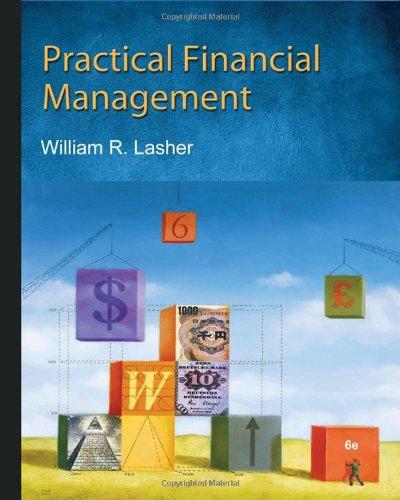Question
Book Title: Investment analysis and portfolio SHOW YOUR WORK. (7 Questions 1. Apply the residual income model to determine the intrinsic value of the stock
Book Title: Investment analysis and portfolio SHOW YOUR WORK. (7 Questions 1. Apply the residual income model to determine the intrinsic value of the stock for a firm with the following financial data: Current Assets $15,000,000 Fixed-Assets $65,000,000 Total Assets $80,000,000 Current Liabilities $10,000,000 Long-Term Debt $50,000,000 Total Liabilities $60,000,000 Stockholder?s Equity $20,000,000 Total Liabilities and Equity $80,000,000 Market price of stock $28.50 # shares outstanding 1,000,000 PE 20X Dividend per share $0.75 Stock?s beta 0.96 Risk-free rate 4.50% Market return 10.00% Intrinsic value of a stock determination is tackled in Chapter 14. However, as to the residual income model- let me suggest you use the following formula: Where: B0 = $20,000,000 ? 2. Calculate the correlation between Stock A and Stock B given the following data: Stock A Stock B Market Beta 1.07 0.75 1.0 Yield 12.05% 9.85% 11.35% Std. Dev. 15.64% 12.63% 14.11% Apply the formula: This problem is based on Chapter 3 and, primarily, on the material presented in Chapter 7. Just somewhat long, but straightforward calculation. Apply the formula: 3. Calculate the expected price at the end of Year 3 for a stock that just paid a $1.65 dividend, consistently pays a 60 percent dividend payout, an ROE of 10.5 percent, and a required return of 15 percent. This problem is based on constant dividend growth model for stock price determination, alternatively called Gordon model, or dividend discount model (DDM). Largely the material form chapter 11. 4. A stock just paid a dividend of $2.00. Due to the introduction of a proprietary product, the dividend growth rate is expected to be 30 percent for the next two years, 15 percent for years 3 and 4, and then return to a constant growth rate assumption of 4 percent thereafter. The required return on the stock is 18 percent. Calculate the current expected price of the stock. This problem is based on constant dividend growth model for stock price determination, alternatively called Gordon model, or dividend discount model (DDM). Largely the material form chapter 11. But the conditions of the so called supernormal growth. Same Chapter 11, please. 5. (a) A potential client asks you how much he would need to invest today (lump sum) to assure a $35,000 annual supplemental 15-year annuity upon retirement in 20 years. The annuity payment would begin at the end of his first year of retirement. Assume an annual investment yield of 8 percent. (b) Rather than investing a lump sum, what would be the annual pre-retirement annuity to obtain the same objective? Again, assume end-of-the-year convention for the pre-retirement annuity (annuity paid at the end of the year) and an annual investment yield of 8 percent. This problem is based on PVIF and PVIFA calculations of streams of cash flows. (I could not, truth being said, find where in the textbook are these time value of money type problems introduced. It looks like students are supposed to be able to do these calculations. Let me know if you experience any trouble with those.) 6. Calculate a) the portfolio return and b) the standard deviation of a three-asset portfolio given the following data: Funds: S&P 500 Intermediate Treasury European Weights 50% 35% 15% Mean 17.23% 8.24% 12.47% Standard deviation 14.04% 8.04% 12.13% Correlation matrix: S&P 500 Intermediate Treasury European S&P 500 1.0 0.71 0.47 Intermediate Treasury 0.71 1.0 0.64 European 0.47 0.64 1.0 Another exercise based on the material in Chapter 7, but for a 3-asset portfolio. 7. Given the following table of data, calculate the Treynor, Sharpe, and Jensen measures of the three portfolio managers and discuss the results. The RFR for the period was 5.45%. Investment Manager Average Annual Return Standard Deviation Beta A 24.2% 26.4% 1.35 B 28.9% 31.5% 1.56 C 25.2% 22.3% 0.87 S&P 500 22.4% 24.6% 1.00 This problem is based on using formulas introduced in Chapter 25: ?Evaluation of Portfolio performance?.
Step by Step Solution
There are 3 Steps involved in it
Step: 1

Get Instant Access to Expert-Tailored Solutions
See step-by-step solutions with expert insights and AI powered tools for academic success
Step: 2

Step: 3

Ace Your Homework with AI
Get the answers you need in no time with our AI-driven, step-by-step assistance
Get Started


